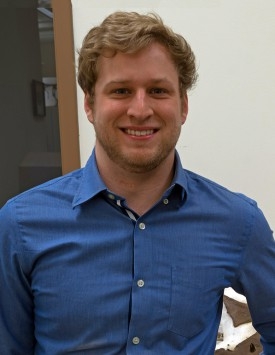Dr. Brenen M. Wynd
PHD FELLOW GRADUATE | Global Change Center
VT Graduate February 2022 • Geosciences
Advisor: Dr. Sterling Nesbitt
Google Scholar • bmwynd@vt.edu • CV

Dr. Brenen successfully defended his PhD dissertation in February of 2022 and is now a Postdoctoral Fellow at Southeastern Louisiana University, working with Dr. April Wright. He works on the application and development of phylogenetic methods for use in analyses with a large proportion of fossils. He joined the lab of Sterling Nesbitt in the fall of 2017 as a PhD student in the Department of Geosciences at Virginia Tech. While at Virginia Tech he studied the ecology and phylogenetics surrounding Triassic archosaurs and their environments.
Brenen graduated from the University of Washington, Seattle (UW), in 2015 with a double B.S. in Biology and Biochemistry, with departmental honors. Brenen was drawn to research after working with Dr. Ronald Kwon on enhancing the anesthetic capabilities in zebrafish (Danio rerio). His research with Dr. Kwon culminated in a first author publication detailing a mechanism of in–vivo imaging using a dynamic anesthesia delivery system. During his final year at UW, Brenen took a Vertebrate Paleontology course, and for a final project Brenen rewrote the Wikipedia page for Thrinaxodon liorhinus, and became completely enamored with the subject. Later that year, he joined the lab of Dr. Christian Sidor, a vertebrate paleontologist studying Permian and Triassic pre-mammalian synapsids.
His work with Dr. Sidor focused heavily on a description of a fossil specimen, Cynognathus crateronotus, and its geographic significance in relation to other Cynognathus-bearing areas. This work has driven him towards wanting to better mass extinction recovery fauna, mostly from Triassic deposits.
Getting involved in Paleontology led to him joining the lab/field with Dr. Gregory Wilson, where Brenen spent nearly two years as an assistant lab manager and research assistant, working with lower vertebrates from the latest Cretaceous and earliest Paleocene of Montana. Brenen was a member of the field crew that retrieved the “Tufts-Love T. rex” specimen and he is currently studying the diversity and morphology of Cretaceous sharks and rays and their ecological relation to the end-Cretaceous mass extinction event. He plans to use the knowledge he gained to study morphology, phylogeny and ecology in the ancestors of dinosaurs and crocodiles.
The fossil record preserves such rich patterns from earth history, much of which cannot be gleaned from living animals. Of these patterns, mass extinctions have been one of the most-heavily studied. They allow us to better understand catastrophic extinction and the macro-evolutionary response of surviving animals. Through the Interfaces of Global Change IGEP Brenen hopes to further study these patterns through the scope of conservation paleobiology; using the fossil record to influence current thoughts regarding conservation in context to mass extinction events.
Last updated November 2022.


